Diploblastic - Study guides, Class notes & Summaries
Looking for the best study guides, study notes and summaries about Diploblastic? On this page you'll find 55 study documents about Diploblastic.
Page 2 out of 55 results
Sort by
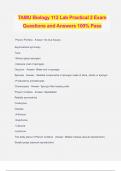
-
TAMU Biology 112 Lab Practical 2 Exam Questions and Answers 100% Pass
- Exam (elaborations) • 23 pages • 2024
- Available in package deal
-
- $12.49
- + learn more
TAMU Biology 112 Lab Practical 2 Exam Questions and Answers 100% Pass Phylum Porifera - Answer- No true tissues Asymmetrical symmetry Taxa: -Silicea (glass sponges) -Calcarea (rest of sponges) Osculum - Answer- Water exit in sponges Spicules - Answer- -Skeletal components of sponges made of silica, calcite or spongin -Produced by amoebocytes Choanocytes - Answer- Spong's filter-feeding cells Phylum Cnidaria - Answer- Diploblastic Radially symmetrical Cnidocytes Classes: -Anthozoa...
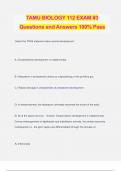
-
TAMU BIOLOGY 112 EXAM #3 Questions and Answers 100% Pass
- Exam (elaborations) • 33 pages • 2024
- Available in package deal
-
- $13.49
- + learn more
TAMU BIOLOGY 112 EXAM #3 Questions and Answers 100% Pass Select the TRUE statement about animal development: A.) Deuterostome development is indeterminate. B.) Mesoderm in protostomes arises as outpocketings of the primitive gut. C.) Radial cleavage is characteristic of protostome development. D) In deuterostomes, the blastopore ultimately becomes the mouth of the adult. E) All of the above are true. - Answer- Deuterostome development is indeterminate. During embryogenesis of diploblasti...
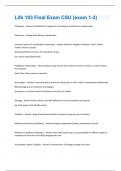
-
Life 103 Final Exam CSU (exam 1-3) Questions & Answers Already Passed!!
- Exam (elaborations) • 15 pages • 2024
- Available in package deal
-
- $7.99
- + learn more
Phylogeny - Answer-Classification of organisms according to evolutionary relationships. Taxonomy - Answer-Evolutionary classification Linnaean system of classification (taxonomy) - Answer-Domain> Kingdom> Phylum> Class> Order> Family> Genus> Species (Did King Phillip Come Over For Grandma's Soup) [ex. Homo sapien](italicized) Phylogeny relationships - Answer-Basal Group: Branch from oldest common ancestor, no other branch from species. Sister Taxa: Share common ance...
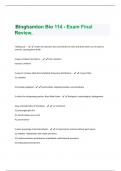
-
Binghamton Bio 114 - Exam Final Review Latest with complete solution
- Exam (elaborations) • 52 pages • 2024
- Available in package deal
-
- $7.99
- + learn more
"Salting out" - certain ions become too concentrated in soils and draw water out of roots by osmosis, causing plant death 2 types of lateral meristems: - Cork cambium vascular cambium 2 ways to increase allele diversity/allele frequency distribution: - 1.) gene flow 2.) mutation 3 Chordate Subphyla - Urochordata, Cephalochordata, and Vertebrata 3 criteria for designating species: Boys Make Pasta - biological, morphological, phylogenetic 4 key characteristics of chordates - 1.) notochor...
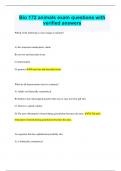
-
Bio 172 animals exam questions with verified answers
- Exam (elaborations) • 19 pages • 2024
- Available in package deal
-
- $9.99
- + learn more
Bio 172 animals exam questions with verified answers Which of the following is (are) unique to animals? A) the structural carbohydrate, chitin B) nervous and muscular tissue C) heterotrophy D) gametes B) nervous and muscular tissue What do all deuterostomes have in common? A) Adults are bilaterally symmetrical. B) Embryos have pharyngeal pouches that may or may not form gill slits. C) All have a spinal column. D) The pore (blastopore) formed during gastrulation becomes the anu...
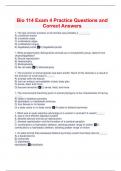
-
Bio 114 Exam 4 Practice Questions and Correct Answers
- Exam (elaborations) • 16 pages • 2024
-
Available in package deal
-
- $10.49
- + learn more
1. The last common ancestor of all animals was probably a ________. A) unicellular chytrid B) unicellular yeast C) multicellular algae D) multicellular fungus E) flagellated protist E) flagellated protist 1. What synapomorphy distinguishes animals as a monophyletic group, distinct from choanoflagellates? A) Sexual reproduction B) Heterotrophy C) Multicellularity D) No cell walls C) Multicellularity 1. The evolution of animal species has been prolific. Much of this diversity is a result of the ...
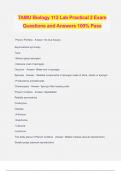
-
TAMU Biology 112 Lab Practical 2 Exam Questions and Answers 100% Pass
- Exam (elaborations) • 23 pages • 2024
- Available in package deal
-
- $13.49
- + learn more
TAMU Biology 112 Lab Practical 2 Exam Questions and Answers 100% Pass Phylum Porifera - Answer- No true tissues Asymmetrical symmetry Taxa: -Silicea (glass sponges) -Calcarea (rest of sponges) Osculum - Answer- Water exit in sponges Spicules - Answer- -Skeletal components of sponges made of silica, calcite or spongin -Produced by amoebocytes Choanocytes - Answer- Spong's filter-feeding cells Phylum Cnidaria - Answer- Diploblastic Radially symmetrical Cnidocytes Classes: -Anthozoa...
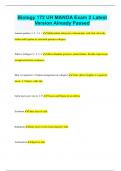
-
Biology 172 UH MANOA Exam 2 Latest Version Already Passed
- Exam (elaborations) • 12 pages • 2024
- Available in package deal
-
- $9.99
- + learn more
Biology 172 UH MANOA Exam 2 Latest Version Already Passed Animal qualities 1. 2. 3. 4. ? (Multicellular eukaryotes, heterotrophs, cells lack cell walls, bodies held together by structural proteins-collagen) What is Collagen? 1. 2. 3. 4. (Most abundant protein in animal bodies, flexible, high tensile strength and elastic resistance) Skin vs Ligament vs Tendon arrangement of collagen? 1skin- dense irregular. 2. Ligament- sheets. 3. Tendon- cable-like Germ layers give rise to 1 2?...
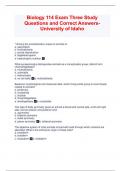
-
Biology 114 Exam Three Study Questions and Correct Answers-University of Idaho
- Exam (elaborations) • 7 pages • 2024
-
Available in package deal
-
- $8.99
- + learn more
**Among the characteristics unique to animals is: a. gastrulation b. multicellularity c. sexual reproduction d. flagellated sperm e. heterotrophic nutrition What synapomorphy distinguishes animals as a monophyletic group, distinct form choanoflagellates? a. multicellularity b. coloniality c. heterotrophy d. no cell walls a. multicellularity Based on morphological and molecular data, which living protist group is most closely related to animals? a. poriferans b. nucleariids c. chytrids d. choa...

-
Biology 1108 Exam 3 Questions and Answers Latest Update | 120 Questions | Graded A+
- Exam (elaborations) • 21 pages • 2023
-
- $16.49
- + learn more
Biology 1108 Exam 3 Questions and Answers (Latest Update) 120 Questions | Graded A+. Alpine - Correct Answers Similar to Tundra, Lacks permafrost, Budding - Correct Answers Form of asexual reproduction in which a bud/protrusion forms on an organism and eventually breaks off to form a new organism that is smaller than its parent. Fragmentation - Correct Answers A type of asexual reproduction in which one organism is broken into pieces, each of which develops into a new individual Partheno...

$6.50 for your textbook summary multiplied by 100 fellow students... Do the math: that's a lot of money! Don't be a thief of your own wallet and start uploading yours now. Discover all about earning on Stuvia


